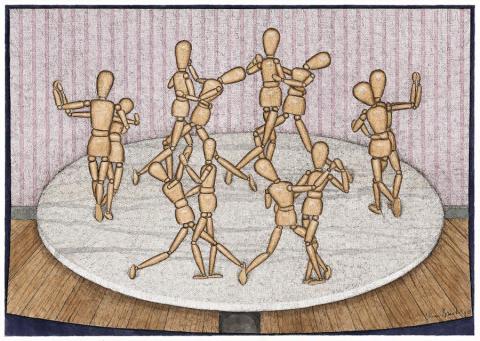SIX COUPLES DANCING, 1992
JOHN BRACK
watercolour, pen and ink on paper
65.0 x 91.0 cm
signed and dated lower right: John Brack ‘92
Private collection, Melbourne
John Brack, Tolarno Galleries, Melbourne, September, 1992
A Question of Balance: John Brack 1974 – 1994, Heide Museum of Modern Art, Melbourne, 1 April – 28 May 2000
The essence of Six Couples Dancing of 1992 is poignantly summarized by Helen Brack in the statement, 'This is a picture about our perpetuation, within the twilight.' In 1991 her husband John Brack began a series of highly composed drawings as 'last reflections upon the human condition' in which he mobilized the usually inert wooden artist's manikin as analogous to mankind's eternal repetitions within the cycle of life.1 He had recently had more grandchildren and at the same time was on the cusp of ceasing painting altogether and thus the manikins evoke a sense of child's play alongside the very serious thoughts inherent in ruminations upon birth, life and death. Interestingly the wooden toy figure of Pinocchio also appears in a number of works in this series interspersed with the characterless manikins. As always with Brack's art, a simple object is borne a deep and often dark significance largely by the way he arranges his subject. Here the eternal return of human action is evoked through the circular arrangement of the wooden figures in a seemingly ceaseless dance upon a round table top barely large enough to contain their robotic-like activities. The portent of an inevitable fall off the shiny marble surface looms large as a metaphor for life and death.
Helen writes fur ther of the dense dynamism of this work, 'The configurations of the Couples change as we stare. The two front ones against the four behind; the four centre couples against the two sentinel couples at each end; and the circulation of the six couples, in continuation, from the picture's right side, to the left, back or up, and across from left to right at the back, to the couple coming down on the right. The straight 'leaders' support the 'performers' although gender seems absent. A feature of the work is that the two back couples are considerably larger than the others, suggesting that they could be adults and the smaller ones younger people; and it is a conundrum that the small couple on the right side show only three legs. The leaders all have vertical heads, the performers' heads all pull at an angle as if driving the circulation. Only the right and left couples have arms bent to right angles, pointing up via their hands - almost as if a statement of boundaries; take care, beware.'
We are grateful to Helen Brack for her kind assistance with this catalogue essay.
1. Gott, T., A Question of Balance: John Brack 1974 - 1994, Heide Museum of Modern Art, Melbourne, 2000, p. 37
LARA NICHOLLS
